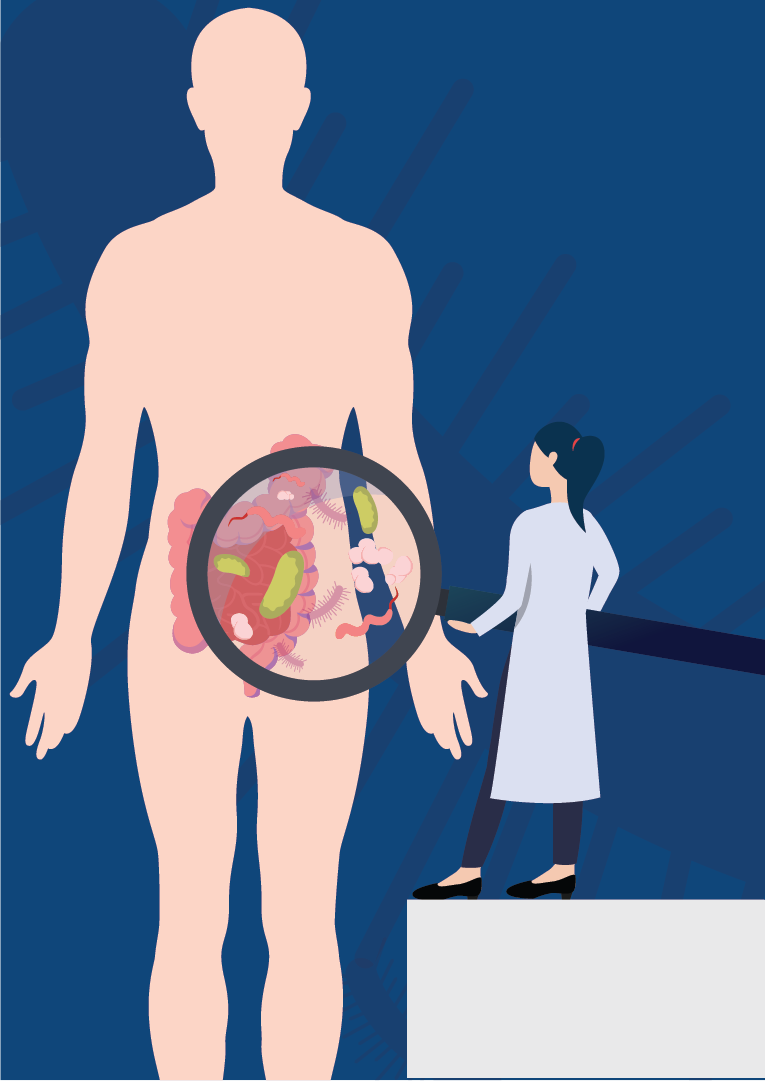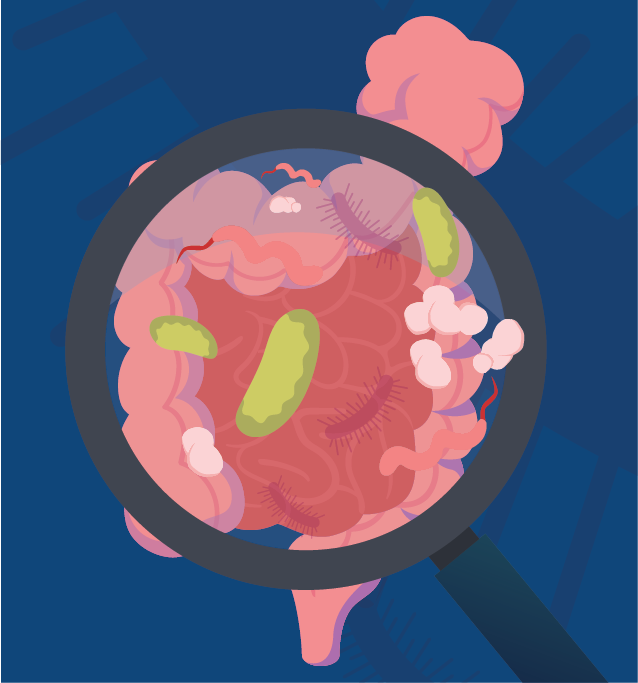GI-Map
Research overwhelmingly indicates that gut health impacts overall health. The gut microbiome, in particular, plays a critical role in mediating the effects of diet and other factors on health, including digestive, immune, metabolic and neuroendocrine functions. Assessing GI health with the proper tools can help practitioners get to the root cause of chronic illness.
The GI-MAP (Microbial Assay Plus) is unique in the field of comprehensive stool testing. It relies exclusively on quantitative polymerase chain reaction (qPCR) technology to detect parasites, bacteria, fungi, and more, by targeting the specific DNA of the organisms tested.

Why Is Quantification Using qPCR Technology So Important?
Unlike other comprehensive stool tests on the market, the GI-MAP can provide practitioners with truly quantitative results. qPCR offers a much more accurate way to detect and quantify clinically-relevant organisms than standard PCR, culture, microscopy, or DNA sequencing-based methods. Accurately assessing how much of an organism’s DNA is present in a patient’s stool sample is essential for helping practitioners to determine the clinical significance of pathogenic organisms and dysbiosis patterns.
qPCR’s Reliability, Reproducibility, and Use in Clinical Research
Although qPCR is becoming more commonplace in in-vitro diagnostics (IVD), we are the only laboratory in the United States exclusively using qPCR technology for advanced comprehensive stool testing. This technology is used routinely in clinical and academic research because it provides highly-accurate quantification, as well as high levels of sensitivity and specificity. Standard PCR technology doesn’t offer the same level of sensitivity, or the ability to express precise numerical results.
The GI-MAP also provides consistently reproducible results. Reproducibility is of crucial importance to the practitioners and patients that rely on the efficacy of the GI-MAP. To achieve it, we perform rigorous quality control, and have validated all molecular target quantification assays to meet or exceed FDA standards.
GI-MAP Allows for the Personalized Treatment Plans and Informative Retests
The GI-MAP’s accuracy and reliability allows practitioners to create personalized treatment protocols to address gut dysfunction based on which infections are urgent, which areas of the gut are already optimized, and which areas should be addressed after an infection is resolved.
Additionally, the quantification offers a remarkable ability to see how treatment modalities are working because a retest after treatment can show whether a parasite has resolved, dysbiosis has improved, and more.
Almost every patient can benefit from a GI-MAP gut health assessment. Some patients are looking to achieve optimal health, while other patients have been chronically ill and frustrated without a diagnosis for years.
Some conditions that warrant testing are:
- Autoimmune diseases
- IBS/IBD
- Digestive complaints, diarrhea or constipation
- Brain fog
- Skin problems, like acne and psoriasis
- Mood disorders, depression, and anxiety
- Diabetes and weight loss issues

Yes. The GI-MAP is commonly used in infants and children, and can provide insight into conditions related to Attentional Deficit Hyperactivity Disorder, Autism, and digestive complaints.
The Gastrointestinal Microbial Assay Plus (GI-MAP) is an innovative clinical tool that measures gastrointestinal microbiota DNA from a single stool sample with state of the art, quantitative polymerase chain reaction (qPCR) technology.
The GI-MAP was designed to detect microbes that may be disturbing normal microbial balance or contributing to illness as well as indicators of digestion, absorption, inflammation, and immune function.
The GI-MAP® includes pathogens (bacterial, parasitic, and viral) commonly known to cause intestinal gastroenteritis. It’s important to note that not all individuals with positive findings for pathogens will present with symptoms. Many factors, including the health of the individual, the transient nature of some pathogens, and the presence and expression of virulence factors all contribute to an individual’s symptoms.
Toxins are a type of virulence factor produced by certain pathogens. Since GI-MAP is a DNA-based test, results reflect the levels of pathogenic strains carrying the toxin genes, not the levels of any toxins that may be produced.
BACTERIAL PATHOGENS
- Campylobacter
- C. difficile Toxin A
- C. difficile Toxin B
- Enterohemorrhagic E. coli
- E. coli O157
- Enteroinvasive E. coli/Shigella
- Enterotoxigenic E. coli LT/ST
- Shiga-like Toxin E. coli stx1
- Shiga-like Toxin E. coli stx2
- Salmonella
- Vibro cholerae
- Yersinia enterocolitica
PARASITIC PATHOGENS
- Cryptosporidium
- Entamoeba histolytica
- Giardia
VIRAL PATHOGENS
- Adrenovirus 40/41
- Norovirus GI/II
Recent studies have shown that nearly 50% of the world’s population may harbor H. pylori. And, although many carriers are asymptomatic, H. pylori is known to have a causative role in ulcers, chronic gastritis, and stomach cancer.
Additionally, in early phases of colonization, patients may experience hypochlorhydria followed by a change to hyper aciduria. Over time, additional H. pylori strains may colonize, including those with Virulence Factors and increased disease potential.
H. PYLORI & VIRULENCE FACTORS
- Helicobacter pylori
- Virulence Factor, babA
- Virulence Factor, cagA
- Virulence Factor, dupA
- Virulence Factor, iceA
- Virulence Factor, oipA
- Virulence Factor, vacA
- Virulence Factor, virB
- Virulence Factor, virD
COMMENSAL/KEYSTONE BACTERIA
Trillions of microorganisms inhabit the human intestine to make up a complex ecosystem that plays an important role in human health. Commensal bacteria extract nutrients and energy from our diets, maintain gut barrier function, produce vitamins (biotin and vitamin K), and protect against colonization by potential pathogens.
COMMENSAL BACTERIA
- Bacteroides fragilis
- Bifidobacterium spp.
- Enterococcus spp.
- Escherichia spp.
- Lactobacillus spp.
- Enterobacter spp.
- Akkermansia muciniphilia
- Faecalbacterium prausnitzii
- Roseburia spp.
BACTERIAL PHYLA
- Bacteroidetes
- Firmicutes
- Firmicutes/Bacteroidetes Ratio
Many bacteria measured on the GI-MAP are considered opportunistic pathogens, as they only cause disease and illness in some individuals, particularly the immune-compromised. Many individuals come into contact with opportunistic bacteria and experience no symptoms. Most sources consider these microbes to be normal in the stool. However, they can cause gastroenteritis and inflammation at high levels in vulnerable patients. Symptoms may include diarrhea, loose stools, abdominal pain, or even constipation.
Overgrowth and excessive colonization by opportunistic bacteria may occur when the commensal bacteria are impaired by poor diet, antibiotic use, parasitic infection, or a weakened immune system. When intestinal permeability is present (see zonulin), these microbes could escape the lumen of the gut and infect extraintestinal sites.
OPPORTUNISTIC/OVERGROWTH MICROBES
- Bicillus spp.
- Enterococcus faecalis
- Enterococcus faecium
- Morganella spp.
- Pseudomonas spp.
- Pseudomonas aeruginosa
- Staphylococcus spp.
- Staphylococcus aureus
- Streptococcus spp.
COMMENSAL OVERGROWTH MICROBES
- Desulfovibrio spp.
- Methanobacteriaceae (family)
INFLAMMATORY & AUTOIMMUNE-RELATED BACTERIA
- Citrobacter spp.
- Citrobacter freundii
- Klebsiella spp.
- Klebsiella pneumoniae
- M. avium subsp. paratuberculosis
- Proteus spp.
- Proteus mirabilis
COMMENSAL INFLAMMATORY & AUTOIMMINE-RELATED BACTERIA
- Enterobacter spp.
- Escherichia spp.
- Fusobacterium spp.
- Prevotella copri
FUNGI/YEAST
Fungal organisms are commonly found in the human digestive tract, but fungal overgrowth can cause illness in susceptible individuals. Fungal growth may be localized in the body. For instance, Candida spp. may be high in the large intestine but normal in the small intestine, and vice versa. In a patient with suspected fungal overgrowth, additional tests may be necessary to understand the complete picture of fungal overgrowth. Urinary D-arabinitol or antibodies to Candida are sometimes used.
FUNGI/YEAST
- Candida spp.
- Candida albicans
- Geotricum spp.
- Microsporidia spp.
- Rhodoturula spp.
VIRUSES
VIRUSES
- Cytomegalovirus
- Epstein Bar Virus
A parasite is an organism that lives and feeds on a host organism at the expense of the host. The GI-MAP tests for pathogenic parasites and protozoa (some of which are non-pathogenic) most commonly occurring in the GI tract. Sources of exposure should be identified and eliminated to prevent reinfection.
PROTOZOA
- Blastocystis hominis
- Chilomastix mesnelli
- Cyclospora spp.
- Dientamoeba fragilis
- Endolimax nana
- Entamoeba coli
- Pentatrichomonas hominis
WORMS
- Ancyclostroma duodenale
- Ascaris lumbricoides
- Necator americanis
- Trichuris trichiura
- Taenia spp.
INTESTINAL HEALTH MARKERS
DIGESTION
- Steatocrit
- Elastase-1
GI MARKERS
- β-Glucuronidase
- Occult Blood – FIT
IMMUNE RESPONSE
- Secretory IgA
- Anti-gliadin IgA
- Eosinophil Activation Protein (EDN)
INFLAMMATION
- Calprotectin
ADD-ON TESTS
- Zonulin
The GI-MAP includes results for detection of antibiotic resistance genes in the microbiome. If an antibiotic resistance gene is present, then that class of antibiotics is designated POSITIVE for antibiotic resistance. A positive result for the presence of resistance genes for a given antibiotic indicates that the antibiotic is not an ideal choice for an antibiotic protocol.
Antibiotic resistance genes apply to all of the microorganisms found in the fecal sample. Since microbes can rapidly share DNA under stress, the presence of antibiotic resistance in any organism is reason enough to avoid that drug class.
Phenotypes | HELOBACTER
- Amoxicillen
- Clarithromycin
- Fluroquinolines
- Tetracycline